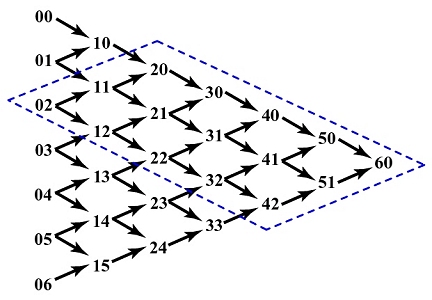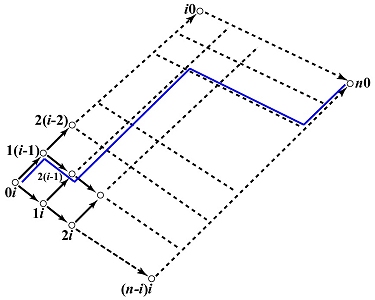

De Casteljau's algorithm looks so different from the naive method that computes each Bn,i(u). A natural question is: does de Casteljau's algorithm correctly compute C(u)? The answer is a "yes" and we will justify this claim.
Let us look at the computation of a Bézier curve defined by 7 control points 00, 01, 02, 03, 04, 05 and 06 as shown below. The point on the curve is 60. Since 60 is computed from the seven control points 00, ..., 06, each of the input control point 0i contributes to the computation of 60. What is this contribution?

Let us investigate the contribution of 02. Since each point ij is multiplied by 1-u (resp., u) to compute its south-east (resp., north-east) neighbor, 02 is used by the computation of 11 and 12. Since 11 (resp., 12) has a component of 02, when 11 (resp., 12) is used to compute 20 and 21 (resp., 21 and 22), the contribution of 02 propagates to 20, 21 and 22. Therefore, the contribution of 02 can only reach the intermediate points in the diamond shape area as shown above.
If we follow the north-east bound arrow starting with 0i, each step causes the first (resp., second) index to be increased (resp., reduced) by one. See the diagram below. After i steps, we will reach point i0. Similarly, if we follow the south-east bound arrow starting with 0i, each step causes the first index to be increased by 1; however, the second index never changes. Therefore, after n - i steps, we will reach point (n-i)i. Now, we have three corners of the diamond shape. The fourth one is, of course, n0. This is shown in the figure below. Verify this claim with the above figure.

How do we determine the contribution of 0i to the computation of n0? This can be obtained by "walking" from 0i to n0. Consider the Bézier curve of degree 6 above as an example. If we follow the directional path 02, 12, 21, 31, 41, 51 and 60, then we have the following:
With this idea in mind, proving the correctness of de Casteljau's algorithm is very simple. Control point 0i contributes to the computation of n0 through all possible paths from 0i to n0. How many paths are there? Think this problem in the following way. Each path always has n arrows. Of these n arrows, i arrows are north-east bound. Hence, the number of ways of inserting these i arrows into n positions is equal to the number of different paths from 0i to n0. This is exactly the combinatorial coefficient C(n,i)=(n!)/(i!(n-i)!). Since the contribution of each path is always ui(1-u)n-i and since we have (n!)/(i!(n-i)!) paths, the total contribution of 0i to n0 is the following:

Therefore, the contribution of control point Pi to the computation of C(u) is exactly the Bernstein polynomial Bn,i(u). Adding the contribution of all control points together, we have the the Bézier curve defined by control points P0, P1, ..., Pn. In conclusion, de Casteljau's algorithm does correctly compute the point on curve corresponding to a given u.